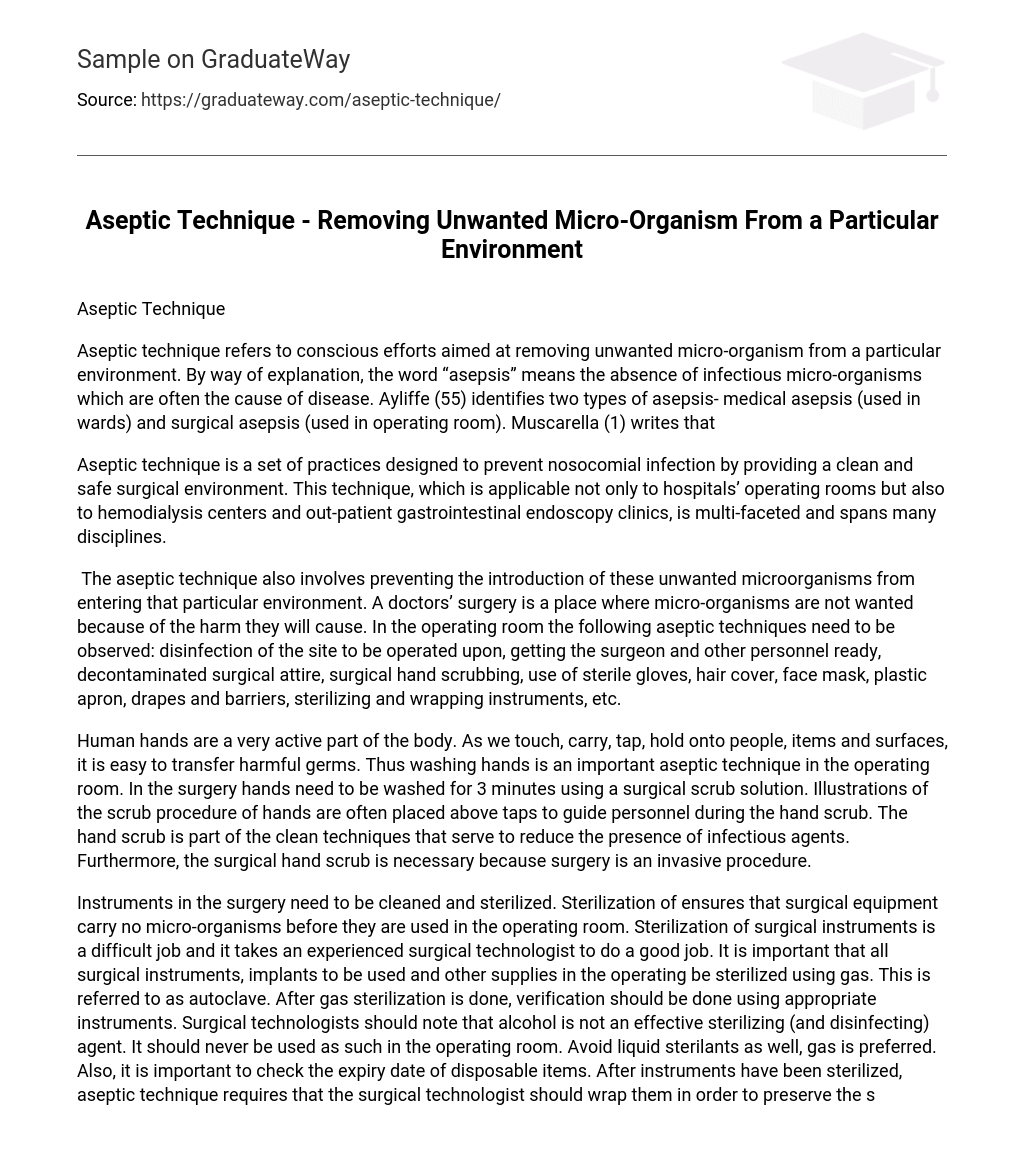Aseptic technique refers to conscious efforts aimed at removing unwanted micro-organism from a particular environment. By way of explanation, the word “asepsis” means the absence of infectious micro-organisms which are often the cause of disease. Ayliffe (55) identifies two types of asepsis- medical asepsis (used in wards) and surgical asepsis (used in operating room). Muscarella (1) writes that
Aseptic technique is a set of practices designed to prevent nosocomial infection by providing a clean and safe surgical environment. This technique, which is applicable not only to hospitals’ operating rooms but also to hemodialysis centers and out-patient gastrointestinal endoscopy clinics, is multi-faceted and spans many disciplines.
The aseptic technique also involves preventing the introduction of these unwanted microorganisms from entering that particular environment. A doctors’ surgery is a place where micro-organisms are not wanted because of the harm they will cause. In the operating room the following aseptic techniques need to be observed: disinfection of the site to be operated upon, getting the surgeon and other personnel ready, decontaminated surgical attire, surgical hand scrubbing, use of sterile gloves, hair cover, face mask, plastic apron, drapes and barriers, sterilizing and wrapping instruments, etc.
Human hands are a very active part of the body. As we touch, carry, tap, hold onto people, items and surfaces, it is easy to transfer harmful germs. Thus washing hands is an important aseptic technique in the operating room. In the surgery hands need to be washed for 3 minutes using a surgical scrub solution. Illustrations of the scrub procedure of hands are often placed above taps to guide personnel during the hand scrub. The hand scrub is part of the clean techniques that serve to reduce the presence of infectious agents. Furthermore, the surgical hand scrub is necessary because surgery is an invasive procedure.
Instruments in the surgery need to be cleaned and sterilized. Sterilization of ensures that surgical equipment carry no micro-organisms before they are used in the operating room. Sterilization of surgical instruments is a difficult job and it takes an experienced surgical technologist to do a good job. It is important that all surgical instruments, implants to be used and other supplies in the operating be sterilized using gas. This is referred to as autoclave.
After gas sterilization is done, verification should be done using appropriate instruments. Surgical technologists should note that alcohol is not an effective sterilizing (and disinfecting) agent. It should never be used as such in the operating room. Avoid liquid sterilants as well, gas is preferred. Also, it is important to check the expiry date of disposable items. After instruments have been sterilized, aseptic technique requires that the surgical technologist should wrap them in order to preserve the sterility before it is used.
Some sterile instruments used in the operating room are disposable, thus need to be dealt with accordingly. Sterile drapes are also an important part of aseptic technique in the operating room. Sterile drapes protect the operative area and also protect surgical instruments and equipment.
Micro-organisms are present everywhere in the environment. Some of these micro-organisms are airborne so one important aspect of aseptic techniques is to ensure that all doors and windows in the doctor’s surgery are shut. A sudden gust of wind can introduce these unwanted micro-organisms into this supposedly sterile environment. Writing on the principles of aseptic technique Schofield (67) notes that there are two methods of sterilization- physical (using heat) and chemical (using gas or liquid chemicals). However this applies to veterinary surgery.
Apart from the doctor’s surgery, micro-organisms are capable of infecting patients in the wards where they lay recuperating. Dressings on wounds, bed sheets, surfaces, toilets and other places and items in the hospital should be kept as clean as possible to prevent the transmission of germs from one patient to the other. On the whole surgical technologists should adhere to aseptic techniques by sterilizing instruments, wrapping, using sterile drapes, hand washing and making sure that the operating room is always clean. Surgical technologist use aseptic techniques during peri-operative, intra-operative and post operative procedure.
Works Cited
- Ayliffe G A J., Fraise A P., Geddes A M., Mitchell K., Control of Hospital Infection: A Practical Handbook 4th edition, Arnold Publishers, London. 2000
- Muscarella, Lawrence F. “Aseptic Technique.” The Q Net Monthly 8.2 (2002):1
- Schofield, J.C. “Principles of Aseptic Technique” Essentials For Animal Research: A Primer For Research Personnel Beltsville, Maryland: National Agricultural Library.1990





